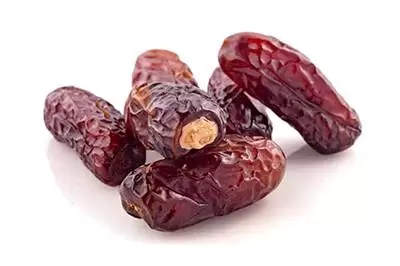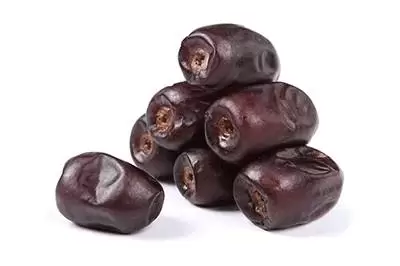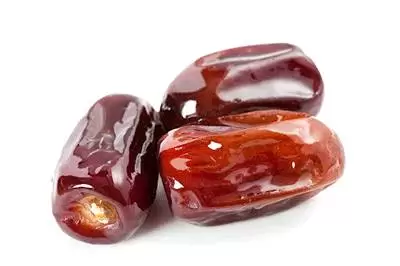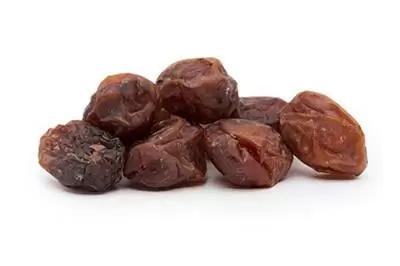
IRANIAN DATES
Iranian dates are sweet, nutrient-rich fruits known for their rich flavor and high quality, often enjoyed as a natural snack or ingredient in various dishes.
What is DATES?
Date trees typically reach about 21–23 metres (69–75 ft) in height, growing singly or forming a clump with several stems from a single root system. Date fruits (dates) are oval-cylindrical, 3–7 cm (1.2–2.8 in) long, and about an inch (2.5 cm) in diameter, ranging from bright red to bright yellow in color, depending on variety. They are very sweet, containing about 75 percent of sugar when dried.
Dates have been a staple food of the Middle East and the Indus Valley for thousands of years. There is archaeological evidence of date cultivation in Arabia from the 6th millennium BCE. The total annual world production of dates amounts to 8.5 million metric tons, countries of the Middle East and North Africa being the largest producers.
In recent years Iran is one of the leading Countries in Date production in the world, with annual production of about 900000 metric tons. Date palm is grown mainly in South, South East, and South West of the Iran. There exists a good opportunity and a large potential for trade in this commodity in Iran. In areas where frosts do not occur the Date palm is the most characteristic representative of irrigation agriculture.


IRANIAN DATES
Iranian dates are celebrated around the world for their extraordinary sweetness, rich flavor, and impressive nutritional benefits. Iran stands out as a leading producer, offering exquisite varieties such as Mazafati, Piarom, and Zahedi. These dates are distinguished by their luscious, caramel-like taste and chewy texture, making them a favorite for snacking and culinary creations.
What makes Iranian dates truly remarkable is not just their superior quality but also the robust market presence they command. Thanks to Iran’s ideal growing conditions and advanced processing methods, these dates are consistently among the best available globally. Their rich flavor profile and health benefits, including high fiber and essential vitamins, make them a sought-after commodity.
Discover the exceptional allure of Iranian dates and see why they’re a standout in the global market!
Why Iranian Dates?

Iranian Dates Varieties
01.
Piarom Dates
Piarom dates, often referred to as "Maryami" dates, are among the most luxurious and sought-after varieties of dates produced in Iran. Grown primarily in the Hormozgan province, particularly around the Hajiabad region, Piarom dates are distinguished by their unique characteristics, making them a favorite both domestically and internationally.


02.
Sayer Dates
Sayer dates are medium-sized, with an oval shape and a deep amber to light brown color. They are a semi-dry variety, meaning they have a firmer texture compared to softer, more moist dates like Mazafati. This semi-dry nature makes them easier to store and transport, which is one reason why they are so popular in international markets.
03.
Rabbi Dates
Rabbi dates are a cherished variety of dates from Iran, particularly cultivated in the southeastern provinces such as Sistan and Baluchestan.
They have a shiny, dark brown to almost black color, which gives them an attractive appearance. The skin of Rabbi dates is relatively thin, smooth, and adheres closely to the flesh, which is soft yet firm. Unlike some other date varieties, Rabbi dates are semi-dry, meaning they strike a perfect balance between moisture and firmness, making them easy to handle, store, and transport.


04.
Shahani Dates
Shahani dates are one of the popular and widely cultivated varieties of dates in Iran, particularly in the Fars province.
They are typically light to golden brown in color, with a thin skin that clings closely to the soft, fleshy interior. Unlike some other date varieties that are semi-dry, Shahani dates are known for their softness and high moisture content, which gives them a tender, almost melt-in-the-mouth texture.
05.
Zahedi Dates
Zahedi dates are medium-sized with an oval shape and a characteristic golden-yellow to light brown color. Unlike softer varieties, Zahedi dates are semi-dry, giving them a firmer texture that is slightly chewy. The skin of Zahedi dates is thin and slightly wrinkled, but it adheres well to the flesh, which is dense and meaty. This semi-dry nature makes Zahedi dates less sticky than other types, making them easy to handle, store, and transport. They are often sold in their whole, pitted form or used in processed forms such as date paste.


06.
Mazafati Dates
Mazafati dates, also known as "Bam dates" due to their primary cultivation in the Bam region of Iran
Mazafati dates are medium-sized, typically dark brown to black in color, with a glossy, smooth skin. These dates are soft and moist, often described as "fleshy," with a tender texture that almost melts in your mouth. The flesh of Mazafati dates is thick and juicy, encasing a small pit that is easily removable.
07.
KabKab Dates
Kabkab dates are one of the well-known and widely cultivated date varieties in Iran, particularly in the provinces of Bushehr and Fars. Kabkab dates are large and oblong, with a dark brown to almost black color when fully ripe. They have a soft, sticky texture with a thick, fleshy interior, making them one of the softer varieties of dates. The skin of Kabkab dates is smooth and shiny, clinging tightly to the juicy flesh inside.


08.
Khasuei Dates
Khasuei dates, also known as "Khasoei" or "Khasui" dates, are a variety of dates primarily cultivated in the province of Fars.
Khasuei dates are generally medium-sized, with an elongated shape. They have a smooth, shiny surface and are often characterized by their uniform appearance. These dates have a dark brown to reddish-brown color when fully ripe, which makes them visually appealing.
09.
Kali Dates

